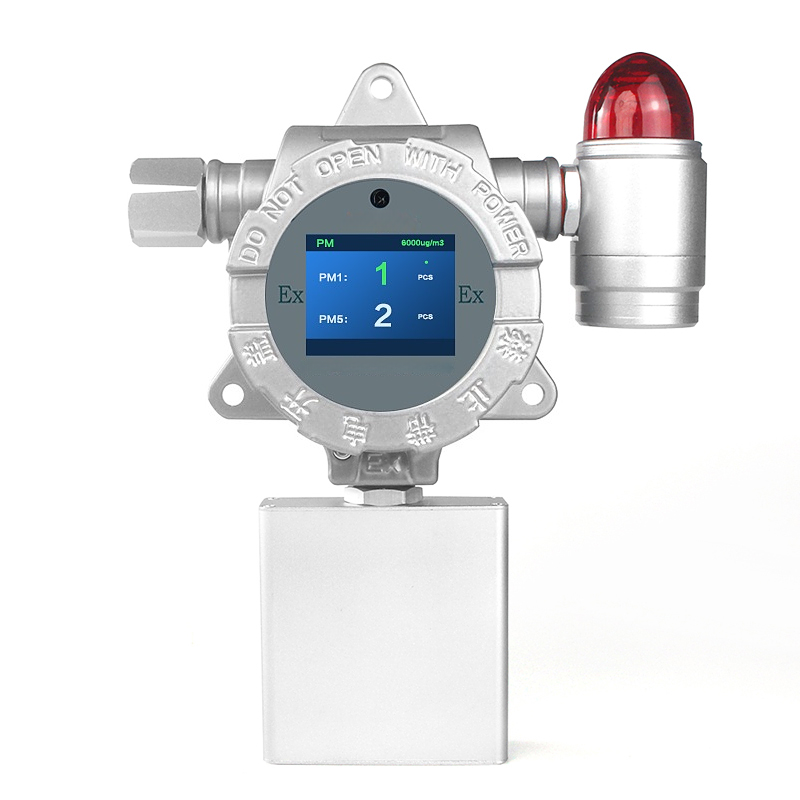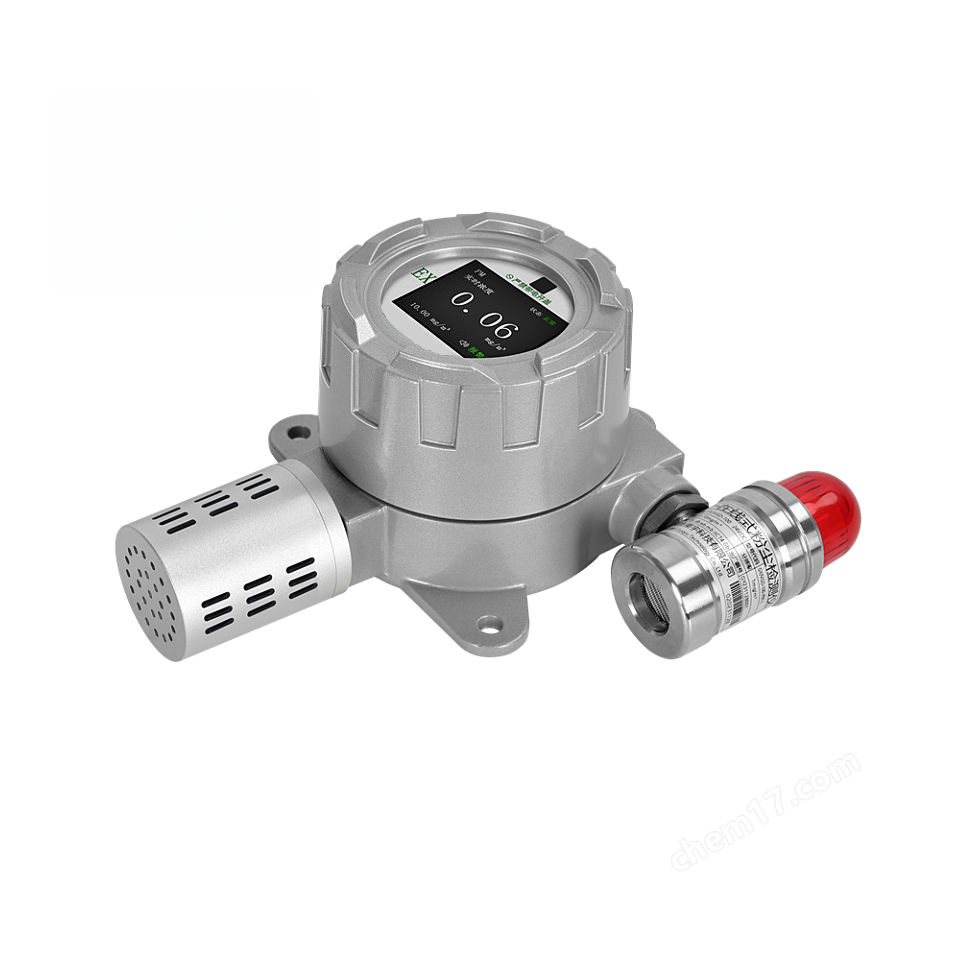PM100/TSP Monitor is a fixed Dust Detector that can continuously detect total suspended particulate matter in the working air.
Through continuous 24-hour online detection and sound and light alarm of dust (PM2.5/PM10/TSP) or particulate matter (the number of particles with a particle size of 0.3um/0.5um/1.0um/2.5um or more) in the atmosphere, it can control the dust concentration or the number of particulate matter in various occasions, and timely protect the safety of life and property in various sites.
Features
Specifications
| Detection gas | Total suspended particulate matter (TSP), dust particles (PM1, PM2.5, PM10) |
| Sensor | Laser sensor |
| Detection method | Diffusion type |
| Installation method | Wall-mounted, pipe type |
| Measurement range | Small range: 0-1000/2000/4000/6000/8000/9999ug/m³; Large range: 0-10/100/1000mg/m³ (range can be customized) |
| Resolution | 0.001, 0.01, 0.1, 1 (depending on the range) |
| Detection error | ≤±5%F.S (≤5% within the full range) |
| Working voltage | DC24V (12V~30V) |
| Relay | Two sets of relay outputs, contact capacity: AC250V3A/DC30V3A |
| Explosion-proof mark | Exib lCT4 Gb/Exib lllCTzo130’C Db |
| Shell material | Die-cast aluminum, explosion-proof and corrosion-resistant |
| Detector size | 285*154*110 (length*width*thickness) mm |
| Working temperature | 25°C~+55°C |
| Working pressure | 86kPa~106kPa |
| Connection port | See the dimension diagram for details |
| Working humidity | <95%RH, no condensation |
| Detector weight | 2.0kg |
| Output signal | ①4-20mA signal: standard 12-bit precision 4-20mA output chip, transmission distance 1Km ②RS485 signal: standard MODBUS RTU protocol, transmission distance 1Km ③Voltage signal: 0.4-2V, 0-5V, 0-10V output, optional (voltage output and current output, one of two) ④Switch signal: standard 1 set of passive contact relay, capacity 220VAC 3A/24VDC 3A ⑤GPRS, 4G, WIFI, LORA, ZigBee and other wireless signals |
| Response time (T90) | ≤30S |
| Working temperature | -20℃~50℃(Special requirements: (-40℃~+70℃) |
| Working humidity | 10-95%RH (non-condensing) |
| Explosion-proof form | The probe transmitter and sensor are both explosion-proof. |
| Optional accessories | Temperature and humidity measurement, 220V to 24V power adapter. Computer monitoring accessories: free host computer software, USB to RS485 conversion cable, if you want network transmission, you also need RS485 to network port converter |
Permissible Dust Concentration in Workplace Air
Please consult sales staff for questions about the exposure limits of various types of dust and the hazards to the human body at certain concentrations.
| No. | Name | Chemical Abstracts Number (CAS No.) | PC-TWA(mg/m3) | |
| Total dust | Respirable dust | |||
| 1 | Dolomite dust | 8 | 4 | |
| 2 | FRP dust | 3 | – | |
| 3 | Tea dust | 2 | – | |
| 4 | Precipitated silica dust | 112926-00-8 | 5 | – |
| 5 | Marble dust | 1317-65-3 | 8 | 4 |
| 6 | Welding fume | 4 | – | |
| 7 | Titanium dioxide dust | 13463-67-7 | 8 | – |
| 8 | Zeolite dust | 5 | – | |
| 9 | Phenolic aldehyde resin dust | 6 | – | |
| 10 | Grain dust(free SiO2<10%) | 4 | – | |
| 11 | Wollastonite dust | 13983-17-0 | 5 | – |
| 12 | Diatomite dust(free SiO2<10%) | 61790-53-2 | 6 | – |
| 13 | Talc dust (free SiO2<10%) | 14807-96-6 | 3 | 1 |
| 14 | Active carbon dust | 64365-11-3 | 5 | – |
| 15 | Polypropylene dust | 5 | – | |
| 16 | Polyacrylonitrile fiber dust | 2 | – | |
| 17 | Polyvinyl chloride (PVC) dust | 9002-86-2 | 5 | – |
| 18 | Polyethylene dust | 9002-88-4 | 5 | – |
| 19 | Aluminum dust: Metal & alloys dust Aluminium oxide dust | 7429-90-5 | 3 4 | – |
| 20 | Hemp dust (free SiO2<10%) Flax Jute Ramie | 1.5 2 3 | – – – | |
| 21 | Coal dust(free SiO2<10%) | 4 | 2.5 | |
| 22 | Cotton dust | 1 | – | |
| 23 | Wood dust | 3 | – | |
| 24 | Condensed silica dust | 1.5 | 0.5 | |
| 25 | Bentonite dust | 1302-78-9 | 6 | – |
| 26 | Fur dust | 8 | – | |
| 27 | Man-made vitreous fiber Fibrous glass dust Slag wool dust Rock wool dust | 3 3 3 | – – – | |
| 28 | Mulberry silk dust | 8 | – | |
| 29 | Grinding wheel dust | 8 | – | |
| 30 | Gypsum dust | 10101-41-4 | 8 | 4 |
| 31 | Limestone dust | 1317-65-3 | 8 | 4 |
| 32 | Asbestos(Asbestos>10%) dust Asbestos fibre | 1332-21-4 | 0.8 0.8f/ml | – – |
| 33 | Graphite dust | 7782-42-5 | 4 | 2 |
| 34 | Cement dust (free SiO2<10%) | 4 | 1.5 | |
| 35 | Carbon black dust | 1333-86-4 | 4 | – |
| 36 | Silicon carbide dust | 409-21-2 | 8 | 4 |
| 37 | Carbon fiber dust | 3 | – | |
| 38 | Silica dust 10%≤free SiO2≤50% 50%<free SiO2≤80% free SiO2>80% | 14808-60-7 | 1 0.7 0.5 | 0.7 0.3 0.2 |
| 39 | Rare earth dust (freeSiO2<10%) | 2.5 | – | |
| 40 | Detergent mixed dust | 1 | – | |
| 41 | Tobacco dust | 2 | – | |
| 42 | Fluorspar mixed dust | 1 | 0.7 | |
| 43 | Mica dust | 12001-26-2 | 2 | 1.5 |
| 44 | Perlite dust | 93763-70-3 | 8 | 4 |
| 45 | Vermiculite dust | 3 | – | |
| 46 | Barite dust | 7727-43-7 | 5 | – |
| 47 | Particles not otherwise regulated a | 8 | – | |
| a: Refers to dust with free SiO2 less than 10%, no asbestos and toxic substances, and no allowable concentration has been established. All kinds of dust listed in the table (except asbestos fiber dust) with free SiO2 higher than 10% are treated as silica dust allowable concentration. For dust, the excessive fluctuation of its short-term exposure level is controlled by the over-limit multiple. Under the premise of meeting PC-TWA, the over-limit multiple of dust is 2 times of PC-TWA. | ||||
What is the Difference between TSP, PM10, and PM2.5?
Suspended particles in the air are dust. If the content of these suspended particles in the air is high, it will cause air pollution. The various substances contained in these dust particles can affect human health. Dust particles can usually be divided into: total suspended particles (TSP), inhalable particles (PM10), and fine dust particles (PM2.5). Here I will introduce the differences and relationships between these three types of particles.
The main difference between the three types of particles, total suspended particles (TSP), inhalable particles (PM10), and fine dust particles (PM2.5), is the size of the particle diameter.
- TSP, also known as PM100, total suspended particles, refers to particles suspended in the air with an aerodynamic equivalent diameter of ≤100μm.
- PM10 refers to particles with a dynamic diameter of ≤10μm.
- PM2.5 refers to particles with a dynamic diameter of ≤2.5μm.
Among them, PM2.5 and PM10 particles are particles that can be inhaled by the human body. Because these particles contain a large amount of impurities, many of which are toxic substances and can cause harm to the human body.
TSP and PM10 and PM2.5 have a layered relationship of inclusion, that is, PM10 is part of TSP, and PM2.5 is part of PM10. The results show that the weight ratio of PM10/TSP is 60%~80%, while the weight ratio of PM2.5/PM10 is 50%~70%. If you want to detect the concentration of PM2.5 and PM10 in the air, you can use a dust concentration detector to detect it.
Featured Applications of Dust Detectors
- Cyclone separators, dust collectors or dust emission control equipment that need to continuously monitor particles;
- Dust detectors are also needed in multi-point monitoring and plant dust production processes;
- Air purifier/ventilation system and indoor and outdoor air quality monitoring;
- Some workshops need to use dust detectors to continuously monitor the integrity of online filters;
- Air quality monitoring of underground transportation systems;
- Laboratories or dust-free workshops for aerosol exposure research;
- Control and monitoring in the process of drying solids;
- Dust detectors can also be used for all air particulate emission monitoring applications;
- Ecological and environmental protection monitoring key to gas construction site dust, PM10, PM2.5, TSP detection, pollutant investigation, etc.;
- Disease prevention core and health supervision institute monitoring and supervision of inhalable particulate matter concentration in public places;
Sino-Inst industrial-grade explosion-proof dust concentration detector can monitor its concentration online in real time 24 hours a day. It is suitable for dust particles (PM1, PM2.5, PM10, TSP).
Sino-Inst’s PM100/TSP Monitor outputs various standard signals and is compatible with various alarm systems, PLC, DCS and other control systems. It is widely used in coating, packaging, metallurgy, flour processing, coal mining, casting and grinding, shipping, environmental protection, telecommunications, medical and other industries.
If you need dust monitoring, please feel free to contact our sales engineers!



